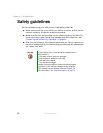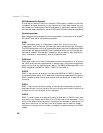79
www.gateway.com
Hub
A switching device through which a number of devices (such as computers)
can be connected to a network. Since connected devices are arrayed with the
hub at the center, this type of connection is referred to as a star topology. Most
hubs used with the Internet are equipped with a signal amplifier (repeater) to
support physical extensions.
IP address
An identifier used to indicate the addresses of devices (such as computers) that
are connected to a network. Because this identifier is used to designate a
particular destination during data exchange, each IP address must be unique.
The address consists of four period-delimited fields, each field being a number
from 0 to 255.
LAN (Local Area Network)
A network encompassing a relatively limited area, such as a building, a floor,
an organization, or a company.
LED (Light-Emitting Diode)
A diode that emits light and is used as a status indicator.
Log
A record of events occurring during operation, along with their times of
occurrence, or the file containing such a record. For example, an error log
contains a list of errors occurring in the NAS, while an access log records access
to the NAS.
Mount
To make accessible, either by connecting to the computer itself or by placing
onto the hard drive or other storage medium of a computer on the network.
Network card
A device installed in a computer or router to enable connection to a network.
A network card is equipped with a port (connector) for connection to a
1000 base-T, 100 Base-TX, 10 Base-T, or other network cable. Also referred to
as a LAN card, LAN board, or NIC (network interface card).
Network system
A system for sharing resources such as files and printers.


















